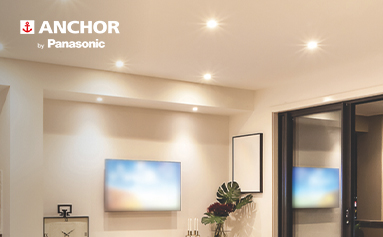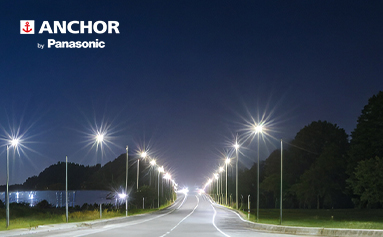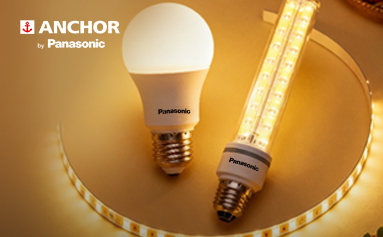- Consumer Products
Back
Consumer Products
- Switches and Sockets
- Accessories
- Wires, Cables and Tapes
Back
Wires, Cables and Tapes
- Switchgear and Protection Devices
- PVC Conduits and Accessories
Back
PVC Conduits and Accessories
- Smart Homes and Buildings
Back
Smart Homes and Buildings
- Fans and Ventilation
- Water Heaters
- LED Lighting
- Solar
- Modular Kitchen
Back
Modular Kitchen
- Home Advancements
Back
Home Advancements
- EV Charger and Accessories
- Home Appliances
Back
Home Appliances
- Switches and Sockets
- Industrial Products
Back
Industrial Products
- Power Tools
- Professional Lighting
Back
Professional Lighting
- Solar
- Conductor Bars
- Inspirations
- About Us
Back
About Us
- Our Story
Back
Our Story
- Manufacturing Excellence
Back
Manufacturing Excellence
- CSR
Back
CSR
- Careers
Back
Careers
- Our Story
Downlights have become an essential feature in contemporary home lighting, blending functionality with sleek aesthetics. These fixtures offer a seamless and unobtrusive lighting solution, providing focused illumination that enhances both ambiance and practicality.
Understanding the versatility and benefits of down light fixtures is key to creating the perfect lighting design.
What Are Downlights and Their Benefits?
A downlight is a lighting fixture installed into the ceiling that directs light downward in a concentrated beam. This design allows for clean, minimalist ceilings without bulky fixtures, making downlights ideal for modern interiors that emphasize simplicity and elegance.
One of the main advantages of down light fixtures is their ability to provide focused lighting that can be used for general illumination, task lighting, or accent lighting. For example, recessed downlights can brighten an entire room evenly, while adjustable models highlight artwork or specific zones. This flexibility makes them suitable for kitchens, living rooms, hallways, bathrooms, and even commercial spaces.
LED downlights further enhance these benefits by offering energy-efficient lighting that reduces electricity consumption and maintenance costs. Their long lifespan and low heat emission make them safer and more sustainable than traditional lighting options. Additionally, recessed downlights create a sleek, flush finish that visually expands a room by keeping the ceiling uncluttered.
The clean lines and unobtrusive nature of down light fixtures allow homeowners to maintain a modern aesthetic while achieving excellent lighting performance.
Types of Downlights
Choosing the right type of downlight depends on your room’s requirements, ceiling type, and design preferences. Here are the most common downlight varieties:
- Recessed Downlights: These fixtures are set into the ceiling for a sleek and unobtrusive appearance. They are perfect for rooms where a minimalist design is desired. Their embedded installation hides the fixture’s body, leaving only the light visible.
- Surface-Mounted Downlights: These fixtures attach directly to the ceiling surface, making them ideal for spaces where recessing isn’t possible, such as in concrete ceilings or rooms with limited ceiling depth. Surface-mounted downlights offer greater flexibility in design and installation.
- LED Downlights: Incorporating LED technology, these downlights are energy-efficient and available in various brightness levels and color temperatures. They provide excellent light quality while consuming minimal power.
- Smart Downlights: Integrated with smart home systems, these downlights offer enhanced control through apps or voice commands. Features include dimming, color temperature adjustment, and scheduling, allowing for personalized lighting experiences.
- Black Downlights: A popular design choice, black downlights add a striking contrast to white or light-colored ceilings. They provide a contemporary, sophisticated look and are often used to create dramatic lighting effects.
How to Choose the Right Downlight
Selecting the perfect downlight involves considering several factors to ensure your lighting meets both aesthetic and functional goals:
- Wattage and Lumens: Lumens measure brightness, while wattage indicates energy consumption. Opt for LED downlights that provide high lumens with low wattage for efficiency. Remember that brighter spaces typically require higher lumens, but it’s important to balance brightness with energy use to avoid unnecessary power consumption.
- Beam Angle: Narrow beam angles (15°-30°) focus light on specific areas, ideal for accent lighting. Wider angles (60°-120°) create general illumination. Choosing the correct beam angle can also help reduce glare and shadows, enhancing the comfort and usability of your space.
- Color Temperature: Warm white light (2700K-3000K) is ideal for creating comfortable and welcoming environments, making it well-suited for bedrooms and living areas. In contrast, cool white light (4000K-5000K) is better for kitchens, bathrooms, and offices. The right color temperature can significantly influence the mood of a room, so consider how you want the space to feel when selecting this feature.
- Dimmability: Compatibility with dimmers allows adjustment of light intensity, enhancing mood and saving energy. With dimmable downlights, you can easily switch from bright lighting for tasks to softer illumination for a cozier atmosphere.
- Size and Cutout: Common downlight sizes range from 3 to 6 inches. It’s also important to ensure the cutout size matches your ceiling’s specifications to avoid installation issues.
- Compatibility: Ensure the downlight fits your ceiling type and existing wiring. Checking compatibility beforehand can save time and prevent costly electrical adjustments during installation.
Placement Tips for Maximum Impact
Proper placement of LED downlight is critical to achieving balanced and effective lighting:
- Even Distribution: Space recessed downlights evenly to avoid dark spots or overly bright areas. Typically, 4 to 6 feet apart is recommended depending on ceiling height. This uniform spacing helps create a comfortable and visually appealing environment.
- Highlight Features: Adjustable downlights are perfect for highlighting art, plants, or unique architectural features. Properly placed accent lighting can add depth and character to your interiors, making the space feel more personalized.
- Task Lighting: Position downlights over kitchen counters, desks, or reading areas for focused illumination. This ensures that workspaces are adequately lit, reducing eye strain and improving productivity.
- Layer Lighting: Combine downlights with ambient and decorative lighting like pendants or wall sconces for depth and flexibility. Layered lighting allows you to customize the atmosphere according to different activities and times of day.
- Avoid Glare: Angle fixtures to prevent harsh reflections, especially near screens or glossy surfaces. Correct angling also improves visual comfort and enhances the overall aesthetic of the room.
Advantages of LED Downlights
The integration of LED technology into down light fixtures offers several advantages:
| Feature | Description |
|---|---|
| Energy Efficiency | LED downlights consume up to 80% less energy than incandescent bulbs, lowering bills. |
| Longevity | LEDs last over 50,000 hours, reducing replacement frequency and maintenance costs. |
| Adjustable Color Temp | Many LED downlights allow color temperature adjustment from warm to cool white. |
| Instant Brightness | LEDs reach full brightness immediately without warm-up time. |
| Compact Design | LED technology enables smaller, more discreet fixtures that blend seamlessly into ceilings. |
Durability and Material Considerations
When selecting down light fixtures, material quality is important for durability and heat management. Fixtures made from aluminum or other high-grade metals offer excellent heat dissipation and corrosion resistance, extending the lifespan of your downlights. Powder-coated finishes add scratch resistance and maintain the fixture’s appearance over time.
FAQs
- What is the difference between downlights and spotlights?
Downlights typically provide broad, downward illumination and are often recessed, while spotlights focus a narrow beam and can be adjustable to highlight specific areas.
- Are downlights suitable for all ceiling types?
Most downlights, especially surface-mounted ones, can be installed on various ceilings. Recessed downlights require sufficient ceiling depth for installation.
- How do I choose the right size of downlight?
Consider room size, ceiling height, and beam angle. Smaller rooms may need 3-4 inch downlights, while larger spaces benefit from 5-6 inch fixtures.
- Can downlights be used outdoors?
Yes, but ensure you select downlights rated for outdoor use with appropriate IP ratings to withstand moisture and dust.
- Are LED downlights worth the investment?
They offer energy savings, longer lifespan, reduced heat output, and better lighting quality compared to traditional bulbs.
Conclusion
Incorporating down light fixtures into your home lighting design can significantly enhance both the functionality and visual appeal of your interiors. Whether you prefer the sleek flush look of recessed downlights, the flexibility of surface-mounted models, or the advanced features of LED downlights, these fixtures provide a modern, efficient, and elegant lighting solution. Adding black downlights can create striking contrasts that elevate your décor, while smart downlights offer convenience and customization.
Select more categories








































